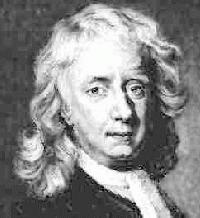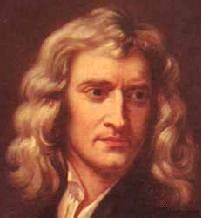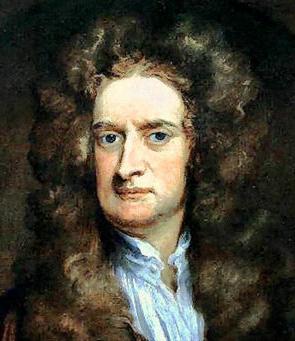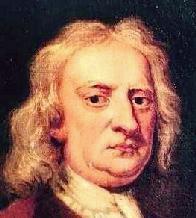ISAAC NEWTON
 (1642 to 1727)
(1642 to 1727)

CONTENTS
 Newton: An Overview Newton: An Overview
 His Life and Works His Life and Works
 Newton's Mysticism Newton's Mysticism
 Newton's Writings Newton's Writings
|
| |
Toward the end of the 1600s
Newton picked up on Descartes' theories of motion and completed the mechanistic
vision of the universe that he had laid out. In his Principia
(1687) he so thoroughly pulled the mechanistic vision together that it
became the single most important foundation piece for the modern world-view.
He "demonstrated" that all
things within the universe are made up of minute bits of matter which are
held together in their shape and movement through the force of natural
attraction or gravity (the gravitational attraction of two bodies is equal
to the product of their mass divided by the square of the distance between
them). This theory explained quite fully everything from the movement of
the planets through the skies, to the movements of the tides, to the velocity
of falling objects – and more.
Just as importantly – the
completeness of the theory left no possibility of seeing creation as a
"living" thing. Creation was without life of its own; it was instead mere
"matter" responding mechanically to a set of fixed mathematical laws.
Nonetheless, Newton thought
of himself as being religiously quite devout. His theory of the universe
– so he thought – was intended as a powerful tribute to the Grand Architect
who designed such a wonderfully complex yet beautiful creation.
However, Newton depicted
God in such a way that God actually lost "personality" and the realm of
sovereign action. God was left a role in nature largely as "First Mover"
with no further significant intervention in life. God nearly became identified
with the eternity or infinity of the universe.
|
|
Growing Up
Isaac Newton was born at Woolsthorpe,
England, in Lincolnshire on Christmas Day, 1642 – to his recently widowed
mother (his father died shortly before Isaac's birth). Three years
later his mother remarried, left young Isaac in the care of his grandmother,
and moved away to join her new husband.
As a youth Isaac was unexceptional
in his studies – until a fight with a fellow student determined him to be
the best performer at school.
When he was in his early
teens, his mother became a widow for the second time and returned to Woolsthorpe.
She also retrieved Isaac from her mother – in order to place him in charge
of the family farm. But he was a daydreamer who preferred to spend
his time thinking about mathematics rather than farming responsibilities.
Finally, an uncle recognized Isaac's natural talents and saw to it that
at he returned to school – in preparation for entry into Cambridge University.
At age 20 he entered Trinity
College, Cambridge, and at 23 (1665) he received his B.A. degree.
He soon thereafter was elected a fellow of Trinity College. But the
Great Plague swept through England that fall, and the university was forced
to close.
 Laying
the Foundations for His Later Work Laying
the Foundations for His Later Work
He returned to the Woolsthorpe
family farm – and to his world of thoughts. In the next 18 months
on the farm he laid out the basic outlines of the very theories that would
eventually reshape Western cosmology! During this time he devised
the binomial theorem, put together the basics of differential calculus,
made the disovery of the color composition of white light, and laid out
the basic lines of his theory on gravity. It was during this time
period of his life that an apple falling from one of the trees on the Woolsthorpe
farm inspired his inquiry into the theory of gravity – as every school child
is well aware!
When in 1667 Newton was able
to return to Cambridge, he did nothing to publicize his work. But
his own former teacher, Isaac Barrow, recognized the brilliance of his
mind and his work – and resigned his university chair, the prestigious Lucasian
professorship in mathematics, in order for that appointment to go to Newton
(age 26).
Optics and Light
He created a very early stir
within English philosophical/scientific circles when he presented to the
Royal society of London a paper on the theory of the constituent colors
of white light (resulting from his work with prisms) and a unique new telescope
that worked with curved mirrors as well as lenses (the reflective telescope).
His color theory was greeted
with skepticism from some quarters – only inspiring him to work harder in
developing his spectral analysis (using the structure of light reflected
off an object to analyze the elemental composition of that object.) and
theories concerning the transmission of light. It was here that he
began to see light and visibility of objects as a result of the rather
mechanical
movement of a host of miniscule particles or "corpuscles" of light through
air, from object to observer, at the speed of about 168,000 miles per second.
 Gravity Gravity
Also – since his return to Woolston
during the Plague, Newton had put his thoughts to the matter of the nature
of the force that holds planets in their particular eliptical course around
the sun – and the moon around the earth. He conceived of this force
as in the strength of a string that holds a ball in a circular course as
we whirl it around and around – until the whirling becomes so great that
the force exceeds the strength of the string and the string snaps, sending
the ball off in flight. The force in the string that held the ball
on course could be measured.
But of course no such string
held the planets to the sun nor the moon to the earth. Yet something
did – and it was precise and measureable.
Another way of looking at
this force was like the fall of an apple to the ground. An attraction
of the planets to the sun and the moon to the earth caused them
to "fall" toward the sun or the earth. But their motion around
the sun and the earth also tend to want to send them off on a tangential
course away from these bodies. They finally took the particular
courses they did around the sun or the earth in a line or trajectory where
these two forces found an equilibrium against each other – that is where
the two opposing forces were equal. These forces were quite open
to precise measurement.
Newton also discovered that
these forces strengthened as two attracting objects approached each other – or
weakened as they were moved away from each other, in a ratio of the square
of their distances. Also he noted that the force attracting two objects
increased or decreased in a ratio of the products of their sizes or mass.
Further, one of Newton's
major refinements in planetary theory was to work from a point at the center
of planetary bodies in calculating the forces of their trajectories – and
not from their surfaces. In this way his gravitational theories worked
without a hitch.
Interestingly his discoveries
in this area came to light through an unusual incident – when some of his
fellow scientists in the Royal Society – Christopher Wren, Edmund Halley,
and Robert Hooke (Newton's arch-rival) – wagered among themselves about
the possibility, within the time frame of two months' study, of coming
up with an explanation about planetary motions. Halley visited Newton,
and described the issue. Newton said he had
already worked
out the answer to just such a problem – but not being able immediately to
find his papers, he informed Halley that he would be pleased to redo his
work. A skeptical Halley was astonished to receive Newton's
work soon thereafter! This prompted Halley to invite Newton to publish
his findings with the Royal Society.

The
Principia – and
the Emerging Newtonian World View
Finally Newton sat down to put
his theories to systematic writing – and the next year, 1687, they were
published as the Philosophiae Naturalis Principia Mathematica.
The publishing of the Principia (through some financial help from
his friends) finally established Newton as the foremost thinker of his
day in the area of mathematics and physics.
The most amazing part of
it all was that it laid at the feet of a quite simple set of mathematical
principles that seemed to unlock the secrets of all sorts of mechanical
relationships that undergirded the behavior of the universe. The
simplicity and beauty of his theories made his work competely compelling
as an explanation of the course of the whole universe – to the extent that
it became the underlying logic of the emerging world view or cosmology
of our modern era.
Newton's Later Years
 In
part because of his opposition in 1687 to King James II's attempt to stamp
a greater Catholic character upon Cambridge University, and in particular
through an attempt to appoint a court favorite to Cambridge University
in 1687, Newton was elected by the University to the new Parliament that
formed when James was ousted from power in the Glorious Revolution of 1688.
His service was fairly brief and unnotable. In
part because of his opposition in 1687 to King James II's attempt to stamp
a greater Catholic character upon Cambridge University, and in particular
through an attempt to appoint a court favorite to Cambridge University
in 1687, Newton was elected by the University to the new Parliament that
formed when James was ousted from power in the Glorious Revolution of 1688.
His service was fairly brief and unnotable.
In 1693 Newton experienced
a deep mental disorder – which he recovered from. But basically he
would never experience again the great moments of brilliance of mind that
had made him such an outstanding individual.
In 1695 he was appointed
warden of the mint – and later master. This position he served ably
though quietly until his death in 1727. In 1703 he was elected President
of the Royal Society – a position he also held until his death. (He
was buried in Westminster Abbey.)
An unfortunate dispute with
Leibniz over the question of who had discovered the calculus arose around
1705 – and darkened somewhat Newton's later years (today it is well accepted
that both had independently developed the calculus at about the same time – though
Newton's work was brought to the attention of the world a bit sooner than
Leibniz's).
|
|
|
What is not as well understood
about Newton was his deep devotion to religion – especially the more mystical
variety of it. Newton considered himself a deeply devout Christian – though
not of the normal sort. He was, in short, a unitarian [one who believes
... that the position of God is not shared by two other "persons,"
namely Jesus and the Holy Spirit; ... that Jesus is rather an adoptive
"Son" of God – as we all have the potential to be – through having lived
a Godly life]. Discovery of his unitarianism would have been ruinous
for Newton in English society – so he kept his religious beliefs well away
from public view.
In any case, he stood himself
before God in great awe – great awe of the One who crafted the universe
with such precision. It was this precision that so inspired Newton – that
he gave his life to its uncovery for human viewing. Science
and mathematics were thus for Newton virtually religious enterprises.
But in addition to this very
rationalistic appreciation of the grandeur of God, there was also an aspect
of his appreciation of God that today would be considered simply superstitious.
While totally logical-rational in his approach to scientific theory, Newton
was strangely mystical in his approach to technology. He was fascinated
with the medieval practice of alchemy (the use of mystical incantations
and magical formulas to change common elements into more precious ones,
such as gold) – and particularly in his later years of life gave even more
time to this pursuit than to science and math.
|
 Newton's
major works or writings: Newton's
major works or writings:
Philosophiae
Naturalis Principia Mathematica (The Principia) (1687)
Opticks (1704)
Papers
and Letters on Natural Philosophy [Collection]
|
 Miles
H. Hodges Miles
H. Hodges
| |
 (1642 to 1727)
(1642 to 1727) (1642 to 1727)
(1642 to 1727)
 Newton: An Overview
Newton: An Overview








